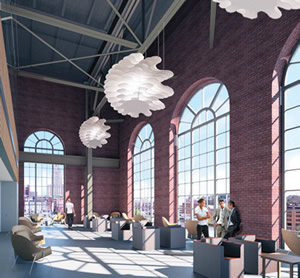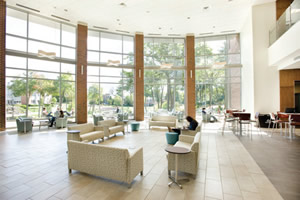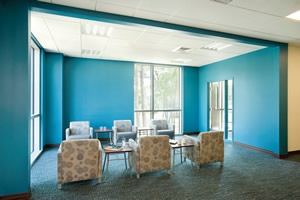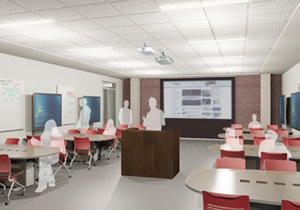Bring Back the Agora!
- By Nicholas Koulbanis
- 01/01/16

IMAGE COURTESY OF CV PROPERTIES & TSOI/KOBUS & ASSOCIATES
Not much has changed in terms of the ways we learn since ancient Greece: teacher at the front, students sitting in rows watching and listening. For centuries, colleges and universities have been designed to accommodate this common-sense approach to education, but the piece that has historically been left out of many of the buildings was the agora, a place for exchanging of ideas between peers.
Over the years, education has become too individually focused, moving away from the group exchange of ideas. However, technology is rapidly evolving, information is available everywhere and the ways we do almost everything are changing. As MOOCs and other online coursework have come into mainstream, colleges and universities have been forced to rethink their roles and provide new and improved social opportunities for students to engage with one another. This in turn has broadened the role of the educator in the classroom and started to redefine what makes a successful learning environment for the 21st-century learner.

PHOTOS © SHELLY HARRISON PHOTOGRAPHY
Early Education
Why is that when we look back to early childhood education the arrangement of the learning spaces are often small groups clustered around a central space? I currently have the opportunity to observe my daughter’s course of learning. She is enrolled in a Reggio Emilia-based preschool where the teacher is not the instructor, but an active participant in a constructivist education process.
In this setting the teachers work alongside the students, guiding them through a series of inquiries and questions around a certain topic or area of focus. They introduce materials and provocative questions/activities that further the exploration of the idea, but the student dictates the direction of the learning and materials are altered to refine the curriculum accordingly. The teacher is a co-learner and collaborator in the process. Through discussions where the students explain what they have learned, teachers are able to understand what they are really processing and how well they grasp the subject. Rather than correcting them, they create further opportunities, explorations and discussions to allow the students to gain a deeper understanding of the subject.
I find myself asking, why is it that when we are in the early stages of learning we learn best in a group setting, through exploration of ideas and peer to peer interaction, but as we advance our education it shifts toward memorization in an instructional setting? Can lessons from early childhood — and Ancient Greece — improve the ways we learn in higher education settings?
Formal Learning Spaces
Today, we find classroom space requirements growing as technologies are introduced and rooms become more flexible to serve a variety of educational modalities. The impact of technology in learning spaces has allowed for new media to be brought into the teaching space and for more collaborations to occur. This has allowed colleges and universities to provide increased opportunities to engage students in discussions, transforming them from passive learners to active participants who learn through discovery, gaining a deeper understanding of the coursework presented.

PHOTOS © SHELLY HARRISON PHOTOGRAPHY
The questions always revolve around what type of space, how much is needed, what level of technology is needed and how flexible the furniture should be. However, you will find that there are no ideal room sizes or furnishings types. It is important to understand the types of classes that will be taught in each space, as well as how the educators and students will be using the technology and furnishings. Students and faculty must be involved in the planning process early and remain involved every step of the way. The most flexible room with the most advanced technology will not make the course; it will only make it easier to facilitate the coursework.
It is important that we ask the right questions and plan for future users so that we create spaces that are flexible with ample writing surfaces, changeable seating and appropriate technology for the activities that are occurring now or could occur in the future. This allows the spaces to easily flex from a traditional lecture setting into that of an active learning environment serving a variety of institutional needs. These spaces, however, will only take you so far unless the support mechanism is in place to help faculty develop and make adjustments to their coursework to take advantage of each room’s capabilities.
Learning spaces should align with the mission of the organization, strategic plan, academic plan and faculty/student initiatives, creating a mixture of space types that allow for a healthy balance of lecture-based and learner-based discussions. Small group meeting spaces, lecture halls, seminar rooms, project spaces and places for display of ideas all have their roles in a successful learning environment. The key is not whether to have one type of space or the other, but to be able to take a space, create flexibility and engage students in multiple modes of learning.
Informal Learning Spaces
Just as important as the registrar’s scheduled learning spaces is the need for informal learning spaces and opportunities to further the learning that has occurred in the classrooms. Wide hallways with seating encourage students to stop and interact as well as remain in the building after their class finishes. This allows for collaboration and sharing of ideas with fellow students and a deeper understanding of the material being covered.
At the same time, it is important that these spaces create a sense of place inside the building. They should be organized adjacent to the teaching space where students and faculty will informally cross paths before and after classes. Spaces should be flexible, well equipped to support technology, able to change over time and support multiple agendas. A variety of sizes of spaces and seating types which include lounge seating and group work tables, as well as high top “coffee bar-style” tables, will allow students to choose from a variety of options and define the space as their own.

IMAGE COURTESY OF CV PROPERTIES & TSOI/KOBUS & ASSOCIATES
GATHER AROUND. When planning learning spaces, it is important to understand the types of classes that will be taught within them as well as how the educators and students will be using technology and furnishings.
Campus Understanding
The shift from lecture-based education to one of peer engagement and critical thinking requires administration to think about the following questions:
- How do we look at all spaces in the building as learning opportunities?
- How do we create spaces for informal collisions and gatherings?
- How can these spaces support the academic mission of the institution?
- How can these opportunities increase and support interdepartmental collaborations?
- How does learning not only spread across the building, but across campus?
Finally, how do we help students engage with one another and become critical thinkers versus being able to recite a formula? This is the advantage that colleges and universities have that is not to be achieved through online coursework. The social learning aspect is an important one that can only be achieved through the exchanging of ideas.
As we plan and design spaces we must look at buildings and campuses as an ecosystem of learning spaces and opportunities for increased social collaboration. Registrars must understand that buildings should no longer be judged by the square-feet-per-student they house, but instead by the overall educational opportunities in both formal and informal learning spaces that take place within.
This article originally appeared in the issue of .